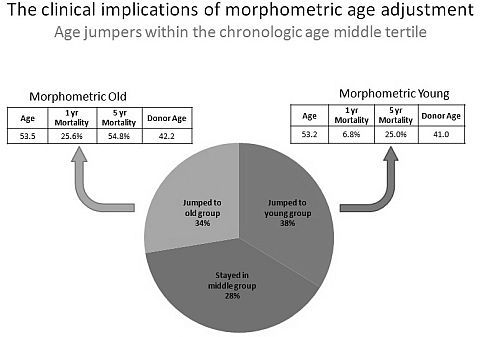Morphometric Age as a Predictor of Post Liver Transplant Survival
General Surgery, Division of Transplant Surgery, University of Michigan, Ann Arbo
Meeting: 2013 American Transplant Congress
Abstract number: 567
INTRODUCTION: Better measures of pre-operative risk stratification are needed in liver transplantation. A cornerstone of a surgeon’s clinical assessment is best described as the “eyeball test”. Potentially, pre-operative imaging can provide objective measures of this subjective surgical assessment by calculating a patient’s morphometric age.
METHODS: The baseline morphometric characteristics of aging were determined using the CT scans of 3313 control patients (trunk muscle size, muscle density, and vascular calcification). Linear regression techniques were then used to define equations of morphometric age. The morphometric age of 348 liver transplant recipients were then calculated and the relationship between morphometric age and survival were explored using univariate and multi-variate techniques.
RESULTS: After adjusting for other clinically relevant covariates, morphometric age was a significant predictor of 1 year mortality (p <0.001, OR = 1.05 95% CI: 1.03 – 1.07) and 5 year mortality (p <0.001, OR = 1.04 per morphometric year, 95% CI: 1.02 – 1.05). Importantly, after adjustment for morphometric age, chronologic age fell out of these risk models. Among the chronologically middle aged tercile, there was a profound difference in 1 and 5 year survival between patients who were “morphometrically” young compared to “morphometrically” old.

CONCLUSION(S): Preoperative imaging can be used to assign a morphometric age to patients, which accurately predicts mortality following liver transplant.
To cite this abstract in AMA style:
Waits S, Kim E, Terjimanian M, Tishberg L, Harbaugh C, Sonnenday C, Englesbe M. Morphometric Age as a Predictor of Post Liver Transplant Survival [abstract]. Am J Transplant. 2013; 13 (suppl 5). https://atcmeetingabstracts.com/abstract/morphometric-age-as-a-predictor-of-post-liver-transplant-survival/. Accessed December 16, 2025.« Back to 2013 American Transplant Congress
